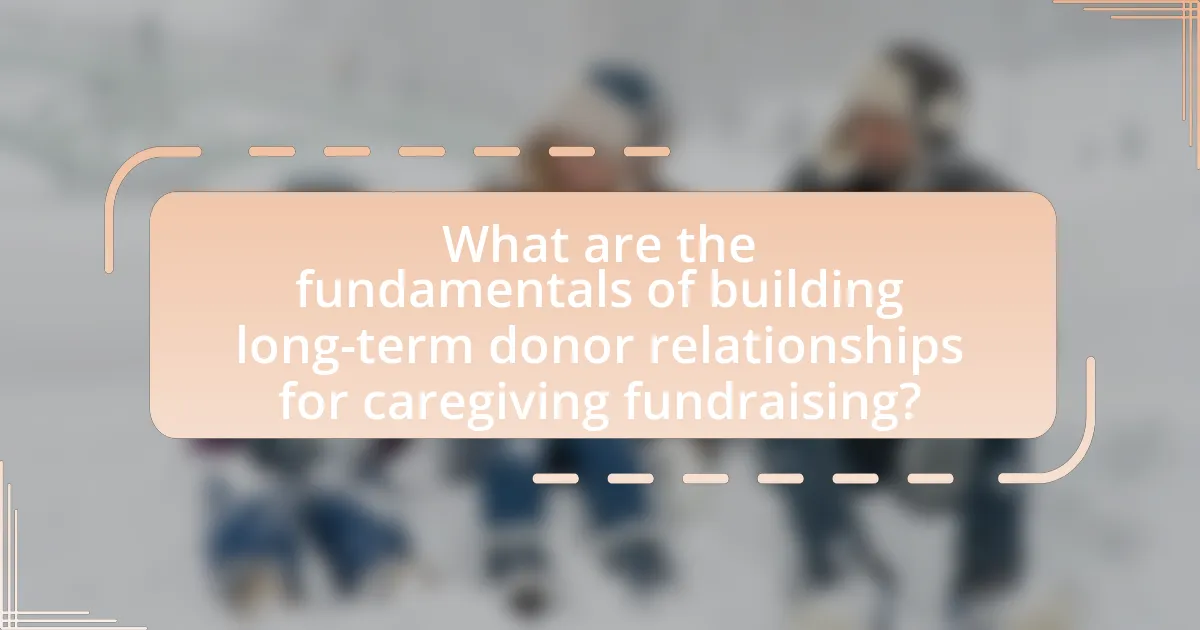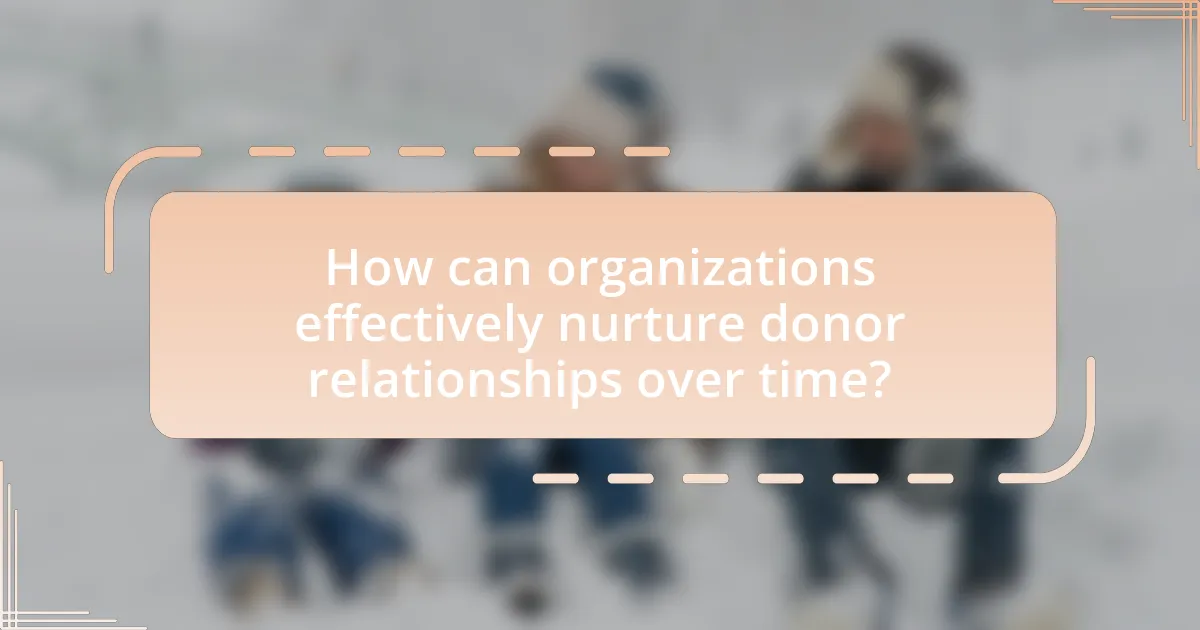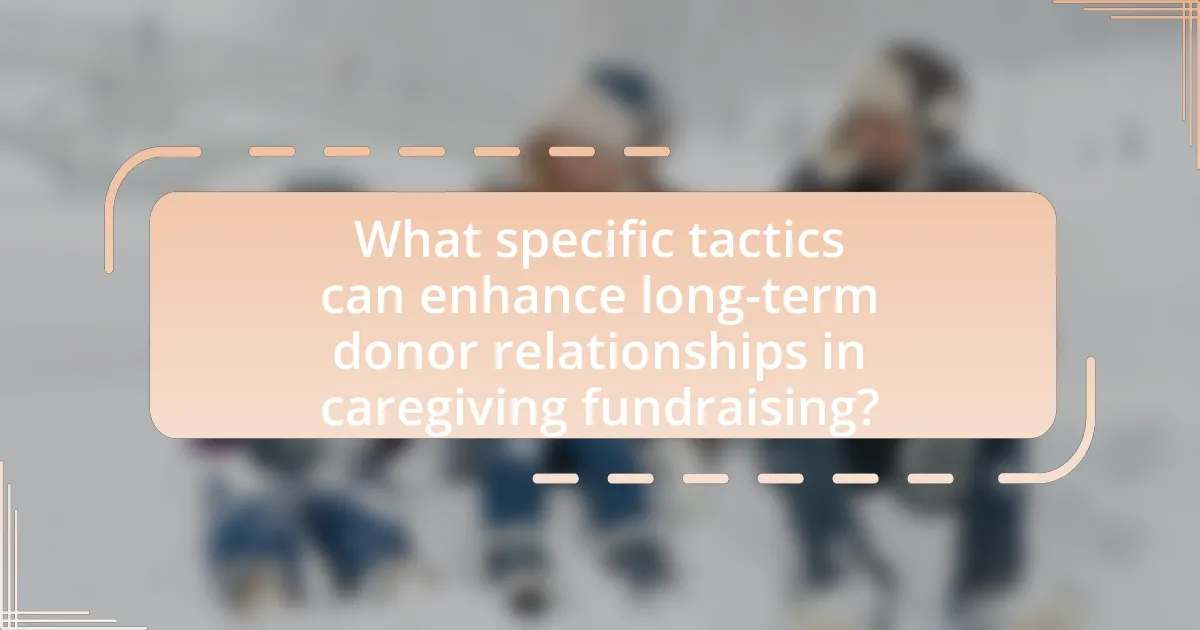The article focuses on the fundamentals of building long-term donor relationships for caregiving fundraising, emphasizing the importance of consistent communication, personalized engagement, and demonstrating impact. It outlines how these elements foster trust and loyalty among donors, leading to higher retention rates and increased lifetime value. Key strategies discussed include effective communication, transparency, and personalized interactions, which are essential for enhancing donor satisfaction and commitment. Additionally, the article addresses challenges organizations may face in relationship-building and offers practical tips for overcoming these obstacles, ultimately highlighting the significance of nurturing donor connections for sustainable fundraising success.

What are the fundamentals of building long-term donor relationships for caregiving fundraising?
The fundamentals of building long-term donor relationships for caregiving fundraising include consistent communication, personalized engagement, and demonstrating impact. Consistent communication ensures that donors feel informed and valued, fostering trust and loyalty. Personalized engagement, such as addressing donors by name and acknowledging their specific contributions, enhances the emotional connection between the donor and the organization. Demonstrating impact through transparent reporting on how donations are utilized reinforces the donor’s sense of purpose and satisfaction. Research indicates that organizations that maintain regular contact and show appreciation for donor contributions experience higher retention rates, with studies showing that a 10% increase in donor retention can lead to a 200% increase in lifetime value.
Why is it important to establish long-term donor relationships?
Establishing long-term donor relationships is crucial because it fosters sustained financial support and engagement for caregiving initiatives. Long-term relationships enhance donor loyalty, leading to increased giving over time; studies show that repeat donors contribute significantly more than one-time donors. Additionally, these relationships facilitate better communication and understanding of donor motivations, allowing organizations to tailor their approaches and increase donor satisfaction. This strategic alignment ultimately results in a more stable funding base, essential for the sustainability of caregiving programs.
What impact do long-term relationships have on fundraising success?
Long-term relationships significantly enhance fundraising success by fostering trust and loyalty among donors. Research indicates that organizations with strong, ongoing relationships with their donors experience higher retention rates, leading to increased lifetime value per donor. For instance, a study by the Association of Fundraising Professionals found that repeat donors contribute, on average, 42% more than first-time donors. This demonstrates that nurturing long-term connections not only secures immediate funding but also builds a sustainable donor base that supports future initiatives.
How do donor relationships influence donor retention rates?
Donor relationships significantly influence donor retention rates by fostering trust and engagement. When organizations cultivate strong relationships with donors through personalized communication, acknowledgment of contributions, and transparency about the impact of donations, donors are more likely to feel valued and connected. Research indicates that organizations with effective donor relationship management can achieve retention rates exceeding 60%, compared to those with weaker relationships, which often see rates below 30%. This correlation underscores the importance of relationship-building strategies in enhancing donor loyalty and long-term support.
What key elements contribute to successful donor relationships?
Key elements that contribute to successful donor relationships include effective communication, transparency, and personalized engagement. Effective communication ensures that donors are informed about the impact of their contributions, fostering trust and loyalty. Transparency involves sharing financial information and project outcomes, which builds credibility and reassures donors about the responsible use of their funds. Personalized engagement, such as tailored updates and recognition of donor contributions, enhances the emotional connection between the organization and the donor, leading to long-term commitment. Research indicates that organizations that prioritize these elements see higher donor retention rates, with studies showing that personalized communication can increase donor engagement by up to 50%.
How does effective communication play a role in donor engagement?
Effective communication is crucial for donor engagement as it fosters trust and transparency between organizations and their supporters. When organizations clearly articulate their mission, impact, and needs, donors feel more connected and informed, which enhances their willingness to contribute. Research indicates that 70% of donors prefer personalized communication, highlighting the importance of tailored messages that resonate with individual donor values and interests. This personalized approach not only increases donor retention rates but also encourages larger contributions, as donors are more likely to support causes they feel emotionally connected to.
What strategies can be employed to personalize donor interactions?
To personalize donor interactions, organizations can implement strategies such as segmenting donors based on their giving history, preferences, and engagement levels. This segmentation allows for tailored communication that resonates with individual donor motivations, enhancing their connection to the cause. For instance, using data analytics, organizations can identify trends in donor behavior and customize outreach efforts, such as personalized thank-you messages or targeted updates on projects they support. Research indicates that personalized communication increases donor retention rates; a study by the Association of Fundraising Professionals found that personalized donor engagement can lead to a 20% increase in repeat donations.
What challenges might organizations face in building these relationships?
Organizations may face several challenges in building long-term donor relationships for caregiving fundraising. One significant challenge is the lack of effective communication strategies, which can lead to misunderstandings and disengagement from donors. Research indicates that organizations often struggle to convey their mission and impact clearly, resulting in a disconnect with potential supporters. Additionally, maintaining donor trust is crucial; any perceived mismanagement of funds can severely damage relationships. According to a study by the Association of Fundraising Professionals, 30% of donors cite lack of transparency as a reason for discontinuing support. Furthermore, organizations may encounter difficulties in personalizing donor interactions, as generic outreach can fail to resonate with individual motivations and interests. This lack of personalization can hinder the development of deeper connections, ultimately affecting donor retention rates.
How can organizations overcome common obstacles in donor engagement?
Organizations can overcome common obstacles in donor engagement by implementing personalized communication strategies and leveraging data analytics. Personalized communication fosters a deeper connection with donors, as studies show that tailored messages increase donor retention rates by up to 50%. Additionally, utilizing data analytics allows organizations to identify donor preferences and behaviors, enabling targeted outreach that resonates with individual motivations. For instance, organizations that segment their donor base and customize their engagement efforts report a 30% increase in donor satisfaction and loyalty. By focusing on these strategies, organizations can effectively address barriers to engagement and build lasting relationships with their donors.
What role does donor fatigue play in long-term relationships?
Donor fatigue significantly impacts long-term relationships by diminishing donor engagement and financial support over time. This phenomenon occurs when donors feel overwhelmed by frequent requests for contributions, leading to decreased motivation to give. Research indicates that 63% of donors report feeling fatigued by constant appeals, which can result in reduced donations or complete withdrawal from supporting organizations. Therefore, managing communication frequency and ensuring meaningful engagement are crucial for maintaining donor interest and commitment in long-term fundraising efforts.

How can organizations effectively nurture donor relationships over time?
Organizations can effectively nurture donor relationships over time by implementing personalized communication strategies and consistent engagement practices. Personalized communication, such as tailored thank-you notes and updates on the impact of donations, fosters a sense of connection and appreciation among donors. Consistent engagement through regular newsletters, invitations to events, and opportunities for donors to participate in organizational activities keeps them informed and involved. Research indicates that organizations that maintain regular contact with donors see a 50% higher retention rate compared to those that do not. This approach not only strengthens relationships but also encourages ongoing support and increased contributions over time.
What are the best practices for maintaining donor engagement?
The best practices for maintaining donor engagement include regular communication, personalized interactions, and demonstrating impact. Regular communication keeps donors informed about organizational activities and achievements, fostering a sense of connection. Personalized interactions, such as addressing donors by name and acknowledging their specific contributions, enhance the relationship and make donors feel valued. Demonstrating impact through reports, stories, and updates on how donations are utilized reinforces the importance of the donor’s support. Research indicates that organizations that maintain consistent and meaningful engagement with donors experience higher retention rates, with studies showing that engaged donors are 50% more likely to continue giving year after year.
How often should organizations communicate with their donors?
Organizations should communicate with their donors at least quarterly. Regular communication, such as quarterly updates, helps maintain engagement and fosters a sense of connection. Research indicates that consistent communication can increase donor retention rates significantly; for instance, organizations that communicate regularly see retention rates of up to 60%, compared to those that do not, which may experience rates as low as 30%. This frequency allows organizations to share impact stories, updates on projects, and express gratitude, reinforcing the relationship and encouraging ongoing support.
What types of content resonate most with long-term donors?
Long-term donors resonate most with content that emphasizes impact stories, transparency, and personalized communication. Impact stories illustrate the tangible outcomes of donations, showcasing real-life examples of how contributions have made a difference, which fosters emotional connections. Transparency in financial reporting and organizational practices builds trust, as donors appreciate knowing how their funds are utilized. Personalized communication, such as tailored updates and acknowledgments, enhances engagement by making donors feel valued and recognized for their contributions. Research indicates that organizations that effectively communicate these elements see higher donor retention rates, reinforcing the importance of these content types in nurturing long-term relationships.
How can organizations measure the success of their donor relationship strategies?
Organizations can measure the success of their donor relationship strategies through metrics such as donor retention rates, average gift size, and the frequency of donations. For instance, a high donor retention rate indicates that organizations are effectively nurturing relationships, as studies show that retaining existing donors is significantly more cost-effective than acquiring new ones. Additionally, tracking the average gift size over time can reveal whether relationships are deepening, while increased donation frequency suggests that donors are more engaged and committed. These metrics provide concrete evidence of the effectiveness of donor relationship strategies, allowing organizations to adjust their approaches based on data-driven insights.
What metrics should be tracked to assess donor engagement?
To assess donor engagement, organizations should track metrics such as donor retention rate, average gift size, frequency of donations, and donor lifetime value. The donor retention rate indicates the percentage of donors who continue to give over time, which is crucial for understanding loyalty. Average gift size reflects the typical amount contributed by donors, helping to gauge financial support levels. Frequency of donations measures how often donors contribute, providing insight into their engagement levels. Donor lifetime value estimates the total revenue a donor is expected to generate throughout their relationship with the organization, highlighting the long-term impact of donor engagement strategies. These metrics collectively provide a comprehensive view of donor engagement and inform strategies for building lasting relationships.
How can feedback from donors inform relationship-building efforts?
Feedback from donors can significantly inform relationship-building efforts by providing insights into donor preferences, motivations, and satisfaction levels. Understanding these aspects allows organizations to tailor their communication strategies and engagement activities to better align with donor expectations. For instance, a study by the Association of Fundraising Professionals found that organizations that actively seek and implement donor feedback experience a 20% increase in donor retention rates. This data underscores the importance of feedback in fostering stronger, more personalized relationships with donors, ultimately enhancing long-term support for caregiving fundraising initiatives.

What specific tactics can enhance long-term donor relationships in caregiving fundraising?
To enhance long-term donor relationships in caregiving fundraising, organizations should implement personalized communication strategies. Tailoring messages to individual donor preferences and interests fosters a sense of connection and appreciation. Research indicates that personalized outreach can increase donor retention rates by up to 50%. Additionally, regular updates on the impact of donations, such as success stories and financial transparency, reinforce trust and engagement. Studies show that donors who receive consistent feedback about their contributions are more likely to continue their support. Lastly, creating opportunities for donors to engage with the organization through events or volunteer opportunities strengthens their emotional investment, leading to sustained relationships.
How can storytelling be used to strengthen donor connections?
Storytelling can strengthen donor connections by creating emotional engagement and fostering a sense of belonging. When organizations share compelling narratives about the impact of donations, they help donors visualize the difference their contributions make, which enhances emotional ties. Research indicates that emotional storytelling can increase donor retention rates by up to 50%, as it resonates with donors on a personal level and reinforces their values and motivations for giving. By illustrating real-life examples of beneficiaries and the positive outcomes of support, organizations can cultivate trust and loyalty among donors, ultimately leading to sustained relationships and increased funding.
What are effective ways to share impact stories with donors?
Effective ways to share impact stories with donors include utilizing personalized communication, leveraging multimedia formats, and showcasing measurable outcomes. Personalized communication, such as tailored emails or handwritten notes, fosters a deeper connection with donors, making them feel valued and engaged. Multimedia formats, including videos and infographics, enhance storytelling by providing visual and emotional context, which can significantly increase donor engagement. Additionally, showcasing measurable outcomes, such as statistics on the number of beneficiaries helped or funds raised, provides concrete evidence of the impact, reinforcing the importance of donor contributions. Research indicates that storytelling combined with data can increase donor retention rates by up to 50%, highlighting the effectiveness of these methods in building long-term relationships.
How does transparency in fundraising efforts affect donor trust?
Transparency in fundraising efforts significantly enhances donor trust. When organizations openly share information about how funds are raised and allocated, donors feel more confident that their contributions are being used effectively and ethically. A study by the Association of Fundraising Professionals found that 92% of donors are more likely to give to organizations that demonstrate transparency in their financial practices. This level of openness fosters a sense of accountability and builds a stronger emotional connection between donors and the organization, ultimately leading to increased donor loyalty and long-term relationships.
What role do events and community engagement play in donor relationships?
Events and community engagement are crucial in fostering strong donor relationships by creating personal connections and enhancing donor loyalty. These interactions allow donors to see the impact of their contributions firsthand, which can lead to increased trust and commitment to the organization. For instance, studies show that organizations that host regular events experience a 30% higher donor retention rate compared to those that do not engage their community. Engaging donors through events also provides opportunities for feedback and dialogue, further solidifying their emotional investment in the cause.
How can organizations create meaningful experiences for donors?
Organizations can create meaningful experiences for donors by personalizing communication and demonstrating the impact of their contributions. Personalization can include tailored messages that acknowledge the donor’s specific interests and previous support, which fosters a sense of connection. Demonstrating impact involves sharing stories, statistics, and updates that clearly illustrate how donations are making a difference, such as showing the number of individuals helped or projects funded. Research indicates that 70% of donors feel more engaged when they receive personalized communication, and organizations that effectively communicate impact can increase donor retention rates by up to 25%.
What types of events are most effective for donor engagement?
Fundraising events that are most effective for donor engagement include galas, peer-to-peer fundraising events, and community outreach activities. Galas often attract high-net-worth individuals and provide opportunities for networking and showcasing the organization’s mission, leading to increased donations. Peer-to-peer fundraising events leverage social networks, allowing supporters to raise funds on behalf of the organization, which can significantly expand the donor base. Community outreach activities foster personal connections and demonstrate the impact of donations, enhancing donor loyalty and engagement. Research indicates that organizations utilizing a mix of these event types see a 30% increase in donor retention rates, highlighting their effectiveness in building long-term relationships.
What practical tips can organizations implement to build long-term donor relationships?
Organizations can build long-term donor relationships by implementing consistent communication strategies, personalized engagement, and demonstrating impact. Consistent communication keeps donors informed about organizational activities and successes, fostering a sense of belonging. Personalized engagement, such as tailored thank-you notes or invitations to exclusive events, makes donors feel valued and appreciated. Demonstrating impact through transparent reporting on how donations are used reinforces trust and encourages continued support. Research indicates that organizations that maintain regular contact with donors see a 50% increase in donor retention rates, highlighting the effectiveness of these strategies.
How can organizations create a donor appreciation program?
Organizations can create a donor appreciation program by implementing a structured approach that includes personalized communication, recognition events, and ongoing engagement strategies. Personalized communication involves sending tailored thank-you notes and updates about the impact of donations, which fosters a sense of connection and gratitude. Recognition events, such as donor appreciation dinners or public acknowledgments, provide opportunities for organizations to celebrate their donors and highlight their contributions. Ongoing engagement strategies, including regular newsletters and exclusive donor updates, keep donors informed and involved, reinforcing their importance to the organization. Research shows that organizations with effective donor appreciation programs experience higher donor retention rates, as appreciation fosters loyalty and encourages continued support.
What are some effective follow-up strategies after donor contributions?
Effective follow-up strategies after donor contributions include sending personalized thank-you notes, providing updates on the impact of their donations, and inviting donors to exclusive events. Personalized thank-you notes enhance donor satisfaction and foster a sense of connection, as studies show that acknowledgment increases the likelihood of future contributions. Providing updates on how their contributions are making a difference keeps donors engaged and informed, reinforcing their decision to support the cause. Additionally, inviting donors to exclusive events creates opportunities for deeper engagement and relationship building, which is crucial for long-term donor retention in caregiving fundraising.